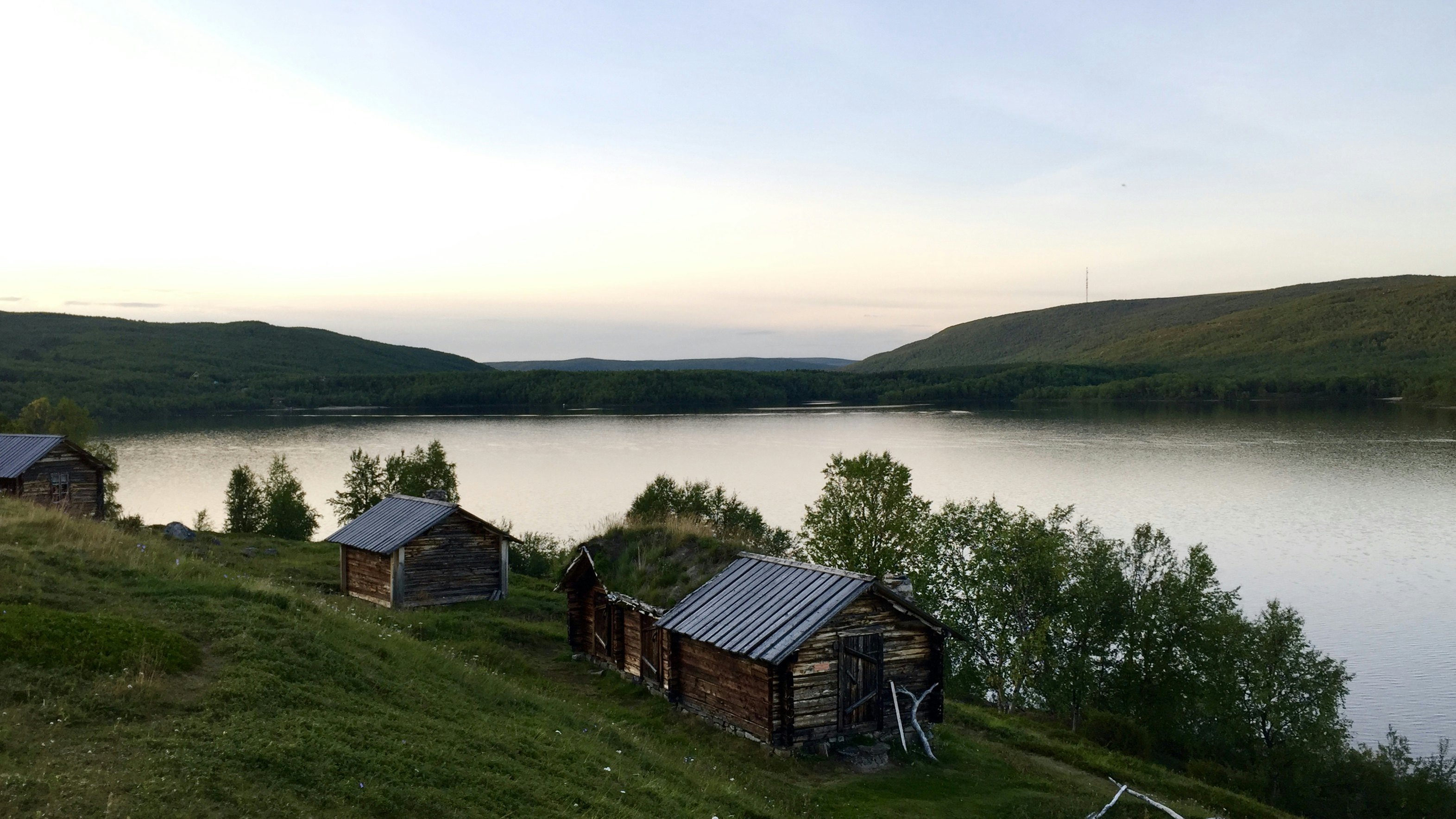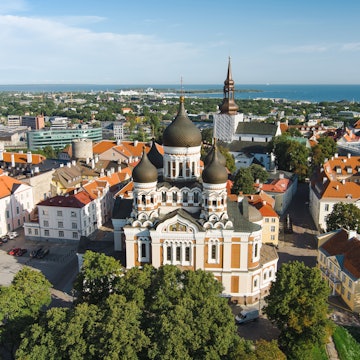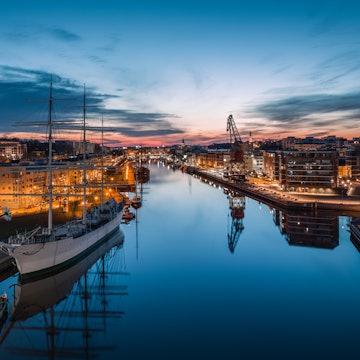

Winter sunset in Lapland. Menno Schaefer/Shutterstock
There aren’t many places where I can guarantee that my 1-year-old cousin and nearly 90-year-old grandpa will have an equally good time, but Lapland is the exception. Walking around the expansive Finnish territory – which shares a border with Sweden, Norway and Russia – you can easily feel the magic of Santa’s spirit in the air. At Finland’s most northeastern reaches, the area feels far removed from the bustle of Helsinki.
While visiting Lapland recently, I based myself in Rovaniemi, the region’s capital. Getting there during the offseason (which includes the northern hemisphere's early autumn and spring months) involved two flights aboard Finnair, the only airline that consistently flies there in September, with a 4-hour layover in between. However, the long travel days were more than worth it.
Tackling this vast Finnish region can be overwhelming, but don't stress – here’s all you need to know before planning your trip to Lapland.

When should I go to Lapland?
By far the most popular time to visit Finland's Lapland is during the winter months of November to January. For a dose of Christmas spirit, snow-covered trees and well below freezing temperatures, which can reach -40ºC (also -40ºF), December is the best time to book a trip to Lapland. However, hotel prices, especially near Santa’s Village in Rovaniemi, nearly triple during the winter months. Autumn, a more budget-friendly time to visit, may not feature winter scenery but still offers a wealth of color. Late September to October is prime time to see the northern lights (also called aurora borealis) and the red, orange and yellow foliage.
For a warmer trip, local guides recommend visiting during August. In the summertime, temperatures average around 15-26ºC (59-79ºF), and the later in the summer you go, the less buggy it will be while hiking or swimming. During the summer, visitors can kayak and canoe in Lapland’s picturesque waters, which they most definitely aren’t able to do in the winter.

Where should I go in Lapland?
Rovaniemi is most notably home to Santa Claus, whom travelers can visit at Santa’s Village. In the village, tourists can meet Santa’s pets, elves and the mystical man himself. The region’s capital is a great place to visit if you have only a few days to spare, but those with more time should explore all Lapland has to offer. In Levi, about a 2-hour bus ride from Rovaniemi, tourists can ski, snowboard and ice fish. Visit the largest ski resort in Finland, Ylläs in Kolari, for the best ski experience. Travel further north to Sápmi and you’ll reach the home of the area's traditional inhabitants: the Sámi.
The Sámi are the Indigenous people who have occupied the region for over 7000 years. Their traditions of reindeer herding, fishing and hunting in the arctic circle extend far beyond Sápmi, as people all over Finland commonly forage for berries and mushrooms in the wilderness. Folklore surrounding the haunting northern lights lives on in the Sámi culture, as many fear and revere the green, pink and red lights that appear in the sky.

How much time should I spend in Lapland?
How long you stay depends on exactly where you go and what you want to do, although people tend to average at least 4 days in the region. During the high season, when direct flights from Europe frequently fly into the Rovaniemi airport, you can easily do a 3-day trip to the capital. However, if you’re visiting during a season when it takes longer to get there, I suggest staying for at least 5 days.
To ski and participate in snow activities, a weekend trip during the winter months is sufficient. If you’re looking to do more than ski or snowmobile, a minimum of 4 days allows for a packed schedule of visiting Santa, going on a reindeer safari, snowmobiling and spending time in a sauna. Staying longer will also give you a better shot at seeing the aurora borealis, which doesn’t appear every night.
Of course, once you’re there, you’ll want to stay longer.

Where should I stay in Lapland?
Rovaniemi is known for its igloo-style hotel suites, giving guests a front-row view of the northern lights and snowy scenery. I stayed at Apukka Resort, approximately 10 minutes outside the city center. The resort goes far beyond other igloo-style hotels by offering dozens of tours, free hiking trails and kayak, canoe and bike rentals. Guests can cruise the breakfast buffet, then try local cuisine for dinner. The resort also provides shuttle service to Santa's Village and Rovaniemi's center.
If polar bears and reindeer are the stars of your Lapland journey, then travel to Ranua, about an hour outside of Rovaniemi, and stay right next to a wildlife park at Ranua Resort, which gives family-friendly tours and invites guests to camp by the park.
During the offseason, most hotels cost between €75 and €350 per night. In the winter, rates rise to upward of €850 per night. For more affordable accommodations, consider a standard room at a hotel like the Postmaster Hotel, which lays out a buffet breakfast and is conveniently located in a central area of Lapland. Backpackers can also choose from several hostels in Rovaniemi, with the Wherever Mini Hostel and Hostel Ibedcity being some of the more affordable options featuring dorms starting at $45.

How can I get to and around Lapland?
Four airports serve Lapland: Rovaniemi, Kittilä, Ivalo and Kuusamo. Several airlines fly to Rovaniemi worldwide; however, most flights from outside Europe require a layover in Helsinki. During the winter high season, travelers can find direct flights to Rovaniemi from major hubs, such as London, for as low as $90. Finnair is the best option year-round as the airline flies to all four airports in Lapland.
Once you’re in Lapland, taxis, which can be booked via a rideshare app like Uber, are readily available in Rovaniemi, but I recommend renting a car if you plan to travel outside the capital. Car rentals start at around $30 per day.

Top things to do in Lapland
Lapland offers numerous activities suitable for people of all ages. When booking a tour, take a moment to ensure that the guide is from Finland or nearby areas, so you’ll receive the most accurate information. While on a northern lights tour, my guide informed me that several operators have been known to tell tourists false information about Sámi and Finnish history.
Try to book Sámi-run tours to learn the most about the history of Lapland. Also search for a company that has received a stamp of approval for sustainability efforts.
Walk with reindeer
In Lapland, you’ll have the option to go on a reindeer or husky excursion. While both are wonderful, reindeer are specific to Lapland, whereas huskies are not. Several companies do reindeer excursions, during which you can walk with them, go on a sleigh ride or explore their habitat.
Unwind in a sauna
“All important decisions are made in the sauna,” a sauna guide told us as we made our way to our private lakeside sauna at Apukka Resort. Sauna culture in Finland is an essential part of daily life, and with 3.3 million saunas around the country, you’d be missing out if you didn’t book a visit to one. I booked the private lakeside sauna, which includes a 90-minute private sauna and a dock on the lake where we could jump into the freezing water and cool off.
Chase the aurora borealis
You can’t visit Finland without at least trying to see the aurora borealis. Once you land in Lapland, you’ll be hit with dozens of tour operators begging you to go on a northern lights tour with them. This is when you should exercise caution. Some tours are known to take visitors around and charge hundreds even when there is no visibility, while others will go to great lengths to ensure that guests see the natural phenomenon.
I went on a private guided northern lights tour with Lappitude, which is run by local guides. We had a custom itinerary, a fireside gathering with snacks (does anything beat homemade cinnamon buns?), and 2 hours packed with stories of Finnish folklore and the guides' experiences living in the arctic circle.
A word of wisdom from the Sámi: don’t whistle at the lights. Legend says that nothing good happens if you whistle at them.
Hike and forage for mushrooms
Lapland during the offseason showcases those stunning Finnish forests. Pyhä-Luosto National Park is an excellent destination to experience the region's diverse range of biodiversity. For a true Finnish experience, keep an eye out for berries and mushrooms to forage. If your foraging skills are still budding, you can opt for a guided hiking and foraging tour.

How much money do I need for Lapland?
Lapland’s beauty definitely comes at a cost. While it is possible to do it on a budget, I recommend saving up some money so you can truly experience the great arctic. Dinner generally costs around €25 per person, with coffee averaging €6 a cup. Tours can range from €50–300.
Night in an igloo hotel room for two during high season: €1000
Night in an igloo hotel room for two during the offseason: €310
Car rental per day: €30
Coffee: €6
Dinner for two: €60–120
Beer: €5–8
















